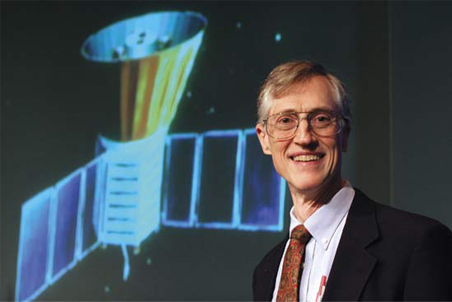 From the Farm to the Nobel Prize: Deciphering the Thursday, October 11, 2007 4 p.m., ACES 2.302 - Avaya Auditorium map
Dr. John C. Mather Head of the Office of Chief Scientist at NASA headquarters in Washington, D.C. Senior Project Scientist for the James Webb Space Telescope Goddard Fellow at NASA/Goddard Space Flight Center in Greebelt, MD. Abstract
The history of the universe in a nutshell, from the Big Bang to now,
and on to the future - John Mather will tell the story of how we got here,
how the Universe began with a Big Bang, how it could have produced an Earth
where sentient beings can live, and how those beings are discovering their
history. Dr. Mather grew up on the Dairy Research Station in Sussex County,
New Jersey where he developed his strong interest in science. At NASA,
he was Project Scientist for the Cosmic Background Explorer (COBE) satellite,
which measured the spectrum (the color) of the heat radiation from the
Big Bang, discovered hot and cold spots in that radiation, and hunted for
the first objects that formed after the great explosion. He will explain
Einstein's biggest mistake, show how Edwin Hubble discovered the expansion
of the universe, how the COBE mission was built, and how the COBE data
support the Big Bang theory. He will also show NASA's plans for the next
great telescope in space, the James Webb Space Telescope. It will look
even farther back in time than the Hubble Space Telescope, and will look
inside the dusty cocoons where stars and planets are being born today.
Planned for launch in 2013, it may lead to another Nobel Prize for some
lucky observer.
This lecture is sponsored by The Endowment for the Antoinette de Vaucouleurs Memorial Lectureship and Medal. | |||||||